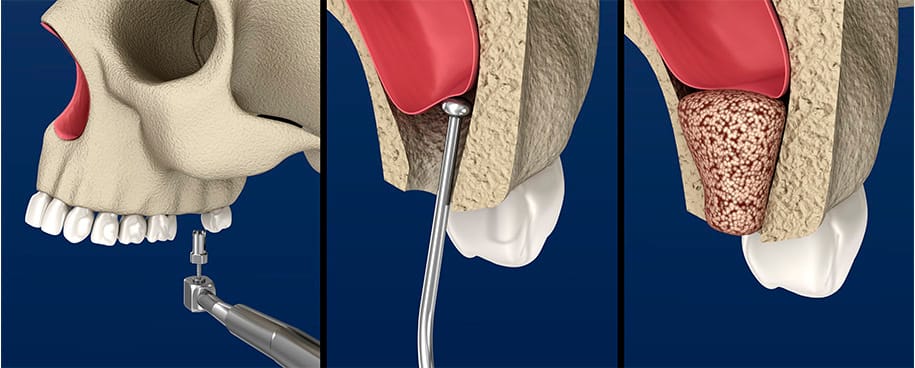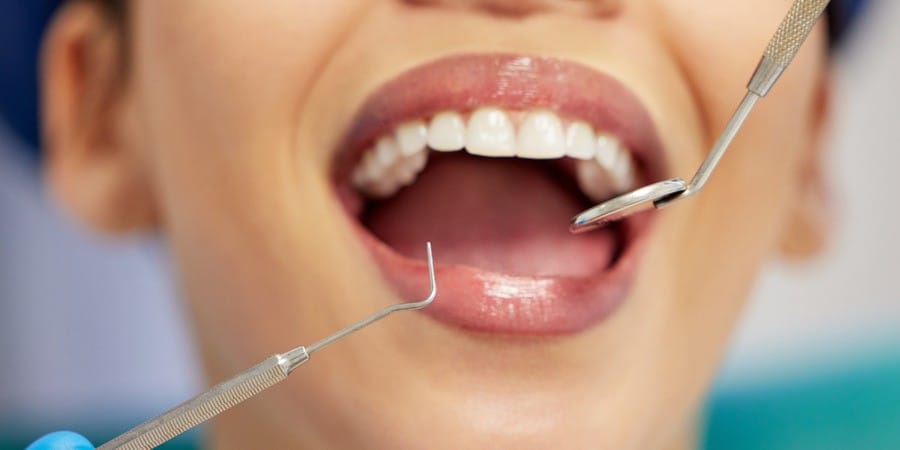What Is a Sinus Lift?
A sinus lift is sometimes called a sinus augmentation. This procedure lifts the membrane between your sinus cavities and jawbone, creating space so that we can fill this area with bone grafting material.

Why Is a Sinus Lift Needed
Your sinus cavities are on either side of your nose, above the back of your upper jaw or maxilla. They are air-filled spaces, and the jawbone beneath them is often naturally thinner and weaker.
Lifting the membrane between the sinus cavities in your jawbone creates additional space that can be packed with bone grafting material. Adding additional bone here can ensure that you have enough volume and density of jawbone to support dental implants adequately.
You may also have inadequate jawbone to support dental implants if you have any of the following issues including:
- Periodontal disease that has destroyed your jawbone.
- Tooth loss where your jawbone has started to resorb.
- Enlarged sinus cavities.
- Other medical conditions that have affected your jawbone.
What Happens If I Need a Sinus Lift?
When you have a dental implant consultation at Clock Tower Dental, we assess your jawbone health carefully using a 3-D digital image called a cone beam CT scan.
The scan is entirely painless and quick but provides invaluable diagnostic information. We can use this scan to quantify how much jawbone is available for implants and where it is located, and we can quickly determine if you have adequate bone.
If you wish to have dental implants to restore upper back teeth, the scan allows us to plan how much bone grafting material must be added to your jawbone to build it up sufficiently.
The cone beam CT scan also allows us to plan your sinus augmentation accurately. We can see the location of important structures like blood vessels and nerves and ensure these are avoided during surgery.
What to Expect During Treatment
Your sinus lift procedure is planned to accommodate your unique oral health needs, which may differ slightly from the steps outlined below.
- Local anesthetic ensures the area treated is thoroughly numbed. However, if you feel anxious, please let us know. We can provide sedation dentistry. The level of sedation will be adjusted to ensure you feel comfortable and relaxed.
- The next stage is to make a small opening in your gum, exposing the jawbone underneath your sinus cavity.
- A tiny opening is made in the bone to expose the membrane between the bone and the sinus cavity.
- Once exposed, we gently lift up the membrane, creating a gap that can be packed with bone grafting material.
- The final stage is to stitch your gums shut so you can heal.
Recovery after Sinus Augmentation
Your sinus lift recovery should proceed smoothly. You may experience some minor bleeding, discomfort, or swelling during the first few days afterward.
Before you leave Clock Tower Dental, we will provide concise instructions on caring for your mouth during healing. We ask you to follow these instructions as closely as possible because they are designed to help you recover more quickly.
Some tips to follow include:
- Take any prescribed antibiotics as instructed, completing the course.
- Follow our instructions on keeping your mouth clean. Initially, you will probably need to avoid brushing your teeth, and we may recommend using an antimicrobial mouth rinse instead.
- Use over-the-counter pain relief to control any discomfort. However, if you experience more significant pain, don’t hesitate to get in touch with us. Our dentist can assess whether the surgery site is healing properly and provide you with a pain relief prescription if necessary.
- Please don’t smoke or vape while you heal, as this will slow down recovery, and the sucking action could dislodge any blood clots protecting the surgery site.
- Please don’t use a drinking straw for the same reason.
- Please try not to sneeze and avoid blowing your nose for the first week afterward.
How Long Will Recovery Take?
Most people can get back to normal after a week or so. However, your sinus lift can take considerably longer to heal completely.
The bone grafting material acts as a scaffold or matrix, encouraging new bone growth. It can take several months for this process to complete or even up to a year for larger bone grafts.
How Soon Can I Have Dental Implants After Sinus Lift Surgery?
If you only require a minimal amount of bone, we may be able to place your implants simultaneously as your bone graft. Otherwise, you must wait until the bone graft has healed completely.
Are there Any Risks with Sinus Lift Surgery?
Sinus lift complications are rare, and we take extensive steps to minimize risks. However, there is always a small chance of complications after any surgical procedure.
Please contact us if you notice any of the following signs or have concerns about your recovery.
- Prolonged bleeding that is worsening.
- Fever or signs of infection or swelling around the bone grafting site.
- Increasing pain.
- A sensation that the bone graft has shifted out of position.
A sinus lift is a very common procedure that our periodontics specialists routinely complete. It can help provide a firm, stable foundation for your dental implants, providing implant teeth that will last for years.

